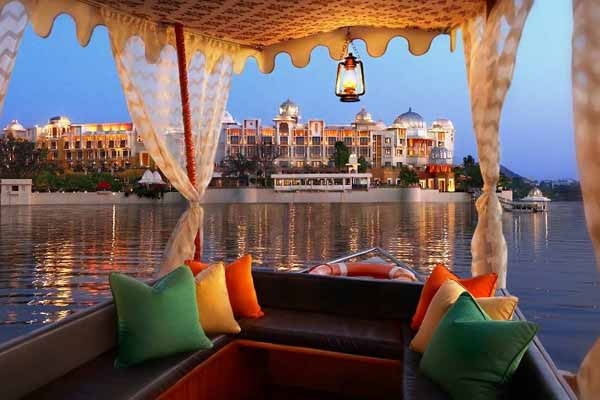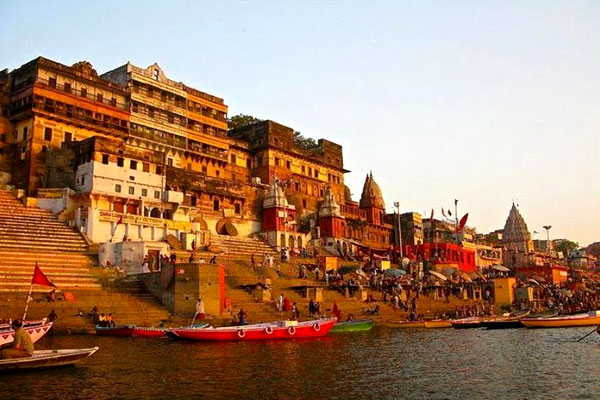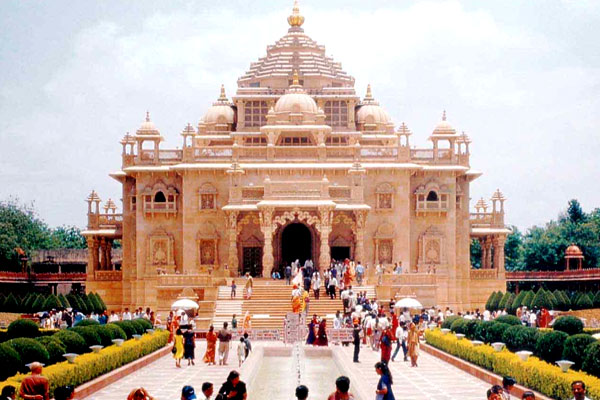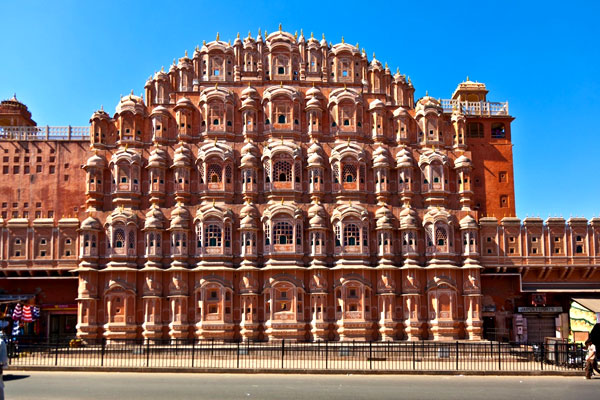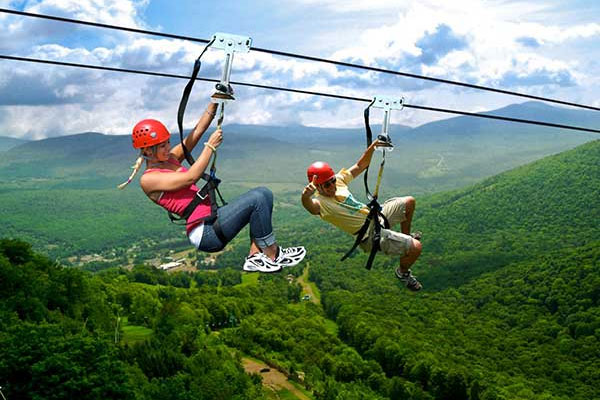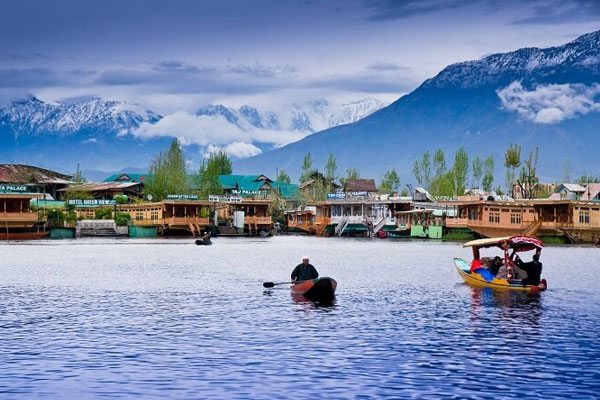Incredible India Tour
- Home
- Tour Packages
- India Luxury Tour Package
- Incredible India Tour
Incredible India Tour
Covered : Delhi – Darjeeling - Delhi - Varanasi – Agra - Fatehpur Sikri - Jaipur - Nimaj - Udaipur - Mumbai – Cochin - Allepey - Kumarakom - Cochin - Delhi – Dehradun - Ananda in the Himalayas – Haridwar - Ananda - Dehradun- No of Nights: 29
- No of Days: 30
Witness Incredible India by spending some time in its finest locations, on which India takes pride. From archeological gems to the serene Backwaters of Kerala, this journey flaunts the best of India. This 30-day-long tour is an extravaganza full of luxury, food, fun-activities, heritage, culture, shopping, history and modern amenities. As to tour starts to come to an end, you will rejuvenate yourself with sheer peacefulness in one of India’s top ten luxury spa, Ananda Resort and Spa.
Day 1: Delhi

On reaching Delhi Airport/ Railway Station meet our tour representative who further escorts you to your pre-booked hotel and relax.
Delhi, the capital of India, is a blend of antiquity and vogue. From tourism to education, the city rubs its shoulders with world's finest cities. Delhi is where the Indian political system finds its root. Hi-tech infrastructure and rich heritage are other features that make it a numero uno tourist spot. The city has been ruled by Mughals, British and others, and each of these rulers did the best to adorn the city.
Overnight stay in Delhi.
Day 2: Delhi sightseeing
On this day of the tour, have your breakfast and prepare to explore Delhi. Sights to be visited today are Raj Ghat, Red Fort, Qutub Minar, India Gate, Lotus Temple and Dargah Hazrat Nizamuddin (as per the time permits).
Red Fort or Laal Quila is the former residence of Mughal household. It served as the royal residence for about 200 years, till 1857. It was built in 1648 by Mughal Emperor Shah Jahan. UNESCO recognized the fort as a World Heritage Site in 2007. The fort indeed is a symbol of India's nationality and heritage. Every year during the grand celebration of India's Independence Day, the Prime Minister hoists the national flag in front of the fort. Though the structures inside the fort are inspired from Mughal architecture, but a fusion of Timurid, Persian and Hindu styles are also witnessed here.
Qutub Minar, yet another UNESCO World Heritage Site, dates back to 1193 when it was commissioned by Qutb-ud-din Aibak, further construction was carried on by his successor Iltutmish. This is the second tallest Minar in India, with a height of 72.5 meters and 379 steps. The balconies have ornate calligraphy of Quran's verses. Other medieval structures are dotted around Qutub Minar and these are collectively called Qutub Complex.
Lotus Temple or Bahaii Temple other than being an architectural landmark promotes the idea of unity of humanity and religion. Numerous architectural awards have been given in regards to its design. Raj Ghat is the cremation spot of the Father of the Nation, Mahatma Gandhi. People visit this memorial and pay tribute to him for what he did for India. Edwin Lutyens after getting inspired by Arc De Triophe of Paris designed India Gate. This arched gate is dedicated to the martyrs who sacrificed their lives between 1914 and 1921 in different wars like World War I, Third Anglo-Afghan War etc. The structure is a symbol of India's patriotism and greatness of an army man. Dargah Hazrat Nizamuddin is where the magic of Islam gets overwhelming. The monuments here are associated with Mirza Ghalib, Amir, Nizamuddin Aulia and Amir Khusrau.
Stay overnight in hotel.
Day 3: Delhi sightseeing
Have your breakfast and prepare to leave for Akshardham Temple.
This vivid, incredible structure is a Swaminarayan Temple Complex, inspired and developed by Pramukh Swami Maharaj, who is the head of Bochasanwasi Shri Akshar Purushottam Swaminarayan Sanstha. The complex is well-built following the principles of Vastu Shasta and Pancha Shastra. About 20000 statues, motifs, manicured-gardens and stone pillars flawlessly carved give an exquisite look to the complex. Early life of Shree Swaminarayan is narrated in theaters and halls with figurines in realistic ambience. As the sun sets down the horizon, the fountain show of the temple gets kick-started. Akshardham Temple alone attracts more than seventy percent of visitors of New Delhi.
When done with Akshardham, visit Delhi Haat in the evening. This is not just a market where you can buy colorful traditional handicrafts, handlooms and clothing, but here you can enjoy regional dishes and other cultural activities too.
Stay overnight in hotel.
Day 4: Delhi- Darjeeling
After breakfast get timely transfer to Delhi Airport and catch your flight to Bagdogra. On reaching Bagdogra hop aboard the Darjeeling Himalayan Railway to reach Darjeeling. Darjeeling Himalayan Railway meanders through fresh grasslands and tea gardens of the Himalayas. In fact the railways have been regarded as UNESCO World Heritage Site.
Darjeeling, the Queen of Hills is internationally acclaimed for its tea. The whole town is strewn with tea gardens, many of which belong to popular traders. British rulers marked the corners of Darjeeling with their signature structures. British-style schools of Darjeeling are attended by students around India. View of third highest mountain peak of the world and highest peak of India, Kanchenjunga Peak is savored from this town. Darjeeling is nothing less than beauty and serenity combined. Pine trees, rhododendrons, pine trees, magnolias, primulas, orchids and indeed an expansive range of flora is scattered along the town.
Overnight stay in at Darjeeling.
Day 5: Darjeeling
Have your breakfast and proceed for Darjeeling sightseeing. Sites to be visited today include Chowrasta, Observatory Hill and Love Road.
Chowrasta means four roads and here people take a peaceful stroll. There are benches for people to sit and relax. And the view of Kanchenjunga Peak and other Himalayan peaks make the experience even better. Chowrasta or The Mall is indeed the heart of Darjeeling. There are different entertainment options here, whether you want to relax or enjoy surfing internet by accessing free wifi. The golden statue near the entrance is of a Nepali Poet Bhanubhakta Acharya, who translated the Ramayana in Nepali language. Just near Chowrasta is where the Observatory Hill is located. Here, one Hindu and Buddhist temples are nestled adjacent to each other and this is symbolic of harmony between these two religions.
Love Road or Lover's Road is a rather a hidden gem. This beautiful spot is ideal for couples who want to spend some time away from world's hustle and bustle. Needless to say, brilliant view of the Himalayas makes it an unforgettable experience.
In the evening you are free to unwind.
Stay overnight in the hotel.
Day 6: Darjeeling
Have your breakfast and prepare to explore more of Darjeeling. Tiger Hill, Tibetan Refugees Self-Help Centre, Happy Valley Tea Garden and Batasia Loop are to be visited this day.
Tiger Hill, the popular site of Darjeeling is blessed with a soulful view of the Himalayas, which include the sight of world's highest mountain peak, Mount Everest and world's third highest peak, Kanchenjunga peak. River streams of Teesta River, Balason River, Mechi River and Mahanada River are savored from Tiger Hill on a clear day. It is perched at an elevation of 8848 meters, where highest railway station of Darjeeling Himalayan Railway is also located. Sunrise and sunset view from Tiger Hill is highly acclaimed.
Batasia Loop is where the Darjeeling Himalayan Railways meanders through, whilst en route to Siliguri from Darjeeling. It is located in close proximity with Ghoom Railway Station which is named after the popular Ghoom Monastery. On one end of Batasia Loop, there is a war memorial where you can pay tribute to the selfless martyrs. Batasia Loops is indeed an epitome of railway engineering.
Happy Valley Tea Garden is approximately three kilometers away from North Darjeeling. This is the oldest tea estate of Darjeeling, covering an area of 437 acre and situated at a height of 6800 feet. The gardens and bushes of the area are as old as 150 years. During the months of March and May, the production process gets busier. Other than enjoying nature's beauty and refreshing aroma of tea leaves you may learn a lot about processing of tea. Overnight stay in hotel.
Day 7: Darjeeling – Delhi
Have your breakfast and prepare to get transferred to Bagdogra Airport, to catch your flight for Delhi. On reaching Delhi, you get an assisted transfer to your hotel. Check in at your hotel and relax. In the evening you can choose to relax or go shopping in local markets.
Stay overnight in Delhi.
Day 8: Delhi- Varanasi
Have your breakfast and get timely transfer to the airport for catching your flight to Varanasi. On reaching Varanasi, meet our tour representative and get escorted to your pre-booked hotel. Check-in and relax for some time.
After freshening up visit Sarnath, which is 5 miles away from Varanasi. Here, the great Buddha preached his first sermon after attaining enlightenment. His staunch follower and the eminent Mauryan King Ashoka later erected his signatory pillar along with a stupa dedicated to Lord Buddha. The exact spot where Buddha gave his first sermon is where Damekh Stupa, which is 110 feet tall. Needless to say, Sarnath is a significant pilgrimage destination for Buddhists. The Archeological Museum houses a collection of Buddhist relics, antiques, images and other such religious findings.
In the evening, attend the soulful Ganga aarti from the river banks. The priests chant the hymns, ring bells, blow shells and perform other Hindu rituals for the river goddess, Ganga. Significance of these rituals can be explained by our tour representative.
Stay overnight in hotel.
Day 9: Varanasi
Proceed to Daswamedh Ghat early in the morning and take a boat ride on the Ganges. Here you can witness various traditions and rituals of Hinduism. Savor the peaceful sight of sunrise from the babbling river, observe as the birds start to chirp the song of love. Many pilgrims and saints visit this ghat to take a dip in the river and offer prayers to the goddess. Take a leisure stroll while returning to the hotel. On reaching, have your breakfast and freshen up.
Sites to be visited today include Kachori Gali, Khoa Gali, Kinari Bazaar and Vishwanath Gali. Kinari Bazaar is a wedding market and Kachori Gali as its name suggests is known for kachodies which are deep fried snacks and a popular delicacy of Varanasi. Similarly Khoa Gali is known for milk products like paneer.
After this, visit Hindu University Campus, one of the biggest residential universities of Asia. The campus covers an area of 4000 acres. Art Gallery and Mosque of Mughal Emperor Aurangzeb of the university are pretty popular.
Stay overnight in hotel.
Day 10: Varanasi- Agra
Have your breakfast and check out from the hotel after a while. Get timely transfer to the airport for catching the flight to Agra. On reaching Agra, check-in at your pre-booked hotel.
Agra, the city of Mughals, is settled on the banks of River Yamuna. Though the city is growing tremendously in terms of modernization but the Mughal charm is yet not even close to diminishing. Agra's most notable feature, Taj Mahal is one of the Seven Wonders of the World. Along with these masterpieces, Agra Fort and Fatehpur Sikri (just to name a few) epitomize the sublimity of Mughal art and architecture. Agra is a historic city; you can find its name in the Mahabharata where it is named Agrevana.
In the evening, you are free for leisure activities. Indulge in soothing spa treatment of your luxurious hotel.
Stay overnight in the hotel.
Day 11: Agra
Early in the morning proceed to Taj Mahal.
Taj Mahal, one of the Seven Wonders of the World and a UNESCO World Heritage Site doesn't actually need an introduction. This white marble mausoleum was commissioned by Mughal Emperor Shah Jahan for his beloved wife Mumtaz Mahal in 1632. The construction continued for about twenty two years. Often it is called the Jewel of Muslim Art in India. However, the Taj Mahal is a brilliant example of Mughal architecture, but a fusion of Islamic, Persian, Indian and Ottoman Turkish are also adopted in its construction. Calligraphy, jali, inlay, semi-precious stones are few elements that decorate nooks of Taj Mahal.
After Taj Mahal, return to your hotel for sumptuous breakfast and freshening up. Thereafter, proceed for more of Agra sightseeing which includes Sikandra, Agra Fort and Baby Taj.
The great Mughal emperor, Akbar was laid to rest in Sikandra. It is also called the Tomb of Akbar the Great. Spotted and other varieties of deer roam around the manicured garden around the tomb. Akbar, who is eminent because of his legends, himself commissioned this tomb and took care of its construction during his life. However, his son Jahangir completed the construction of this tomb in 1613. This monument is mainly built of red-sandstone, with four marble minarets on its corners. The Tomb of Akbar the Great reflects different religion initiated by Akbar (Deen-E-Ilahi), and this is pretty evident through motifs which are inspired by Islam, Christian, Hindu, Jain and Buddhist styles.
Agra Fort, the UNESCO World Heritage Site, must rightly be called a walled-city rather than a fort. Like other Mughal structures this fort too is built from red-sandstone. It was built by a Hindu king, Raja Badal Singh but was later captivated by the Mughals after the First Battle of Panipat. The Mughals seized a treasure, in which the popular diamond Koh-i-noor was also included.
Baby Taj or Itmad-Ud-Daulah Tomb was commissioned by Nur Jahan, who also was Jahangir's wife, in 1628. The man was a trusted member of Akbar's Court, whose former name was Ghiyas Beg. After getting chosen as Jahangir's chief minister he was given the title of Itmad-Ud-Daulah, which means Pillar of the State. The tomb is primarily built of red-sandstone and white marble; many people say that the interiors are even better than the Taj Mahal. Semi-precious stones like jasper, onyx and topaz were used for decorating it further. Light entered through intricate and ornate jali work.
Thereafter, take a heritage walk with your guide on the other side of Yamuna River, where the history of Mughals is written on edicts of stone. Several relics have been woven together to create a realistic experience of history. All this while, the stunning Taj Mahal will be visible. You may sip a coffee along with the villagers on tea terraces.
Stay overnight in hotel.
Day 12: Agra-Fatehpur Sikri- Jaipur
Have your breakfast and check our form the hotel. Today you proceed to Jaipur, the Pink City and stopover at Fatehpur Sikri to witness yet another work of art by the Great Mughal Emperor Akbar.
The historic city of Fatehpur Sikri happens to be a UNESCO World Heritage Site, which was founded in 1569. It is said that Akbar took great interest carving this city and this is indeed apparent as one looks through the structures and plans of the city. Many of Akbar's legends and his Navratnas (nine gems/ courtiers) were born here. The largest gate of the world, Buland Darwaza is located here in Fatepur Sikri.
Have your lunch and then drive to Jaipur. On reaching, check-in at your hotel and relax.
Jaipur, the Pink City, is the capital of one of India's most effervescent states, Rajasthan. The grandeur and antiquity are two of several aspects of the city that pull the crowd from around the world. Jaipur, along with Delhi and Agra, is a part of the popular Golden Triangle Circuit of India preferred by foreign travelers. Like other Rajasthani cities, Jaipur has forts, palaces and a vibrant culture to flaunt. Over the years, it has emerged as a leading spot for destination weddings of people from India and abroad.
Overnight stay in hotel.
Day 13: Jaipur
Have your breakfast and proceed for sightseeing session of Jaipur. Sites to be visited today include Amber Fort, City Palace, Jantar Mantar and Hawa Mahal.
Amber Fort or Amer Fort is a UNESCO World Heritage Site as a part of Hill-Forts of Rajasthan. It was commissioned by Raja Man Singh in 1592 and his successor Jai Singh completed the construction. Main architectural element adopted in the construction but Mughal styles is also reflected. Jalis, semi-precious stones inlaid and arched gateways are few notable features of the beautiful fort.
City Palace of Jaipur flaunts a fusion of traditional Rajasthani, European and Mughal architecture. It was built sometime between 1729 and 1732 and served as the seat of Maharaja of Jaipur. Chandra Mahal, Mubarak Mahal, Mukut Mahal, Maharani's Palace, City Palace Museum and Shri Govind Dev Temple are few prominent structures inside City Palace.
Jantar Mantar is one of the five observatories built by Jai Singh II. This UNESCO World Heritage Site is home to world's biggest sundial and other astronomical models, which are considered of utmost importance by astrologers and astrology students.
Hawa Mahal, the iconic structure of Jaipur is located in the middle of city's popular market. Hawa Mahal literally means palace of winds and this name owes to the fact that the façade is embellished with several windows that collectively look like a honeycomb. The windows were made for the ladies of royal household to enjoy the hustle and bustle of the market, without getting seen. It was built by 1799 by Pratap Singh.
Stay overnight in hotel.
Day 14: Jaipur
After having scrumptious breakfast, head for Samode Village.
Samode, the historic town, was once the most affluent territory in Amber Kingdom. Prepare now to explore this town by visiting one of its star attractions like Samode Palace. It was built as a Rajput Fort in the 16th century, but was later renovated into a palace by adding Rajput and Mughal styles of architecture in 19th century. And in 1987 it underwent yet another phase of renewal, when it got converted into a heritage hotel. Take a stroll in the Mughal style garden, Samode Bagh, which is spread over an area of 20 acres. Forty-four sandbank colored tents, fusion of Mughal, Rajasthani and Victorian of décor, fountains, painting are few other brilliant things about it.
You can choose to take a leisure stroll around the village or a camel cart ride.
Stay overnight in hotel.
Day 15: Jaipur- Nimaj (Chattra Sagar)
This morning have your breakfast and check out from the hotel for Nimaj.
Nimaj is basically popular for its Nimaj Fort, which dates back to 1733 when it was built by Thakur Jagram Singh. This imposing fort is built in Rajput style with separate wings for men and women. Other than the fort there are various other archeological sites like Magar Mandi Temple which dates back to 9th century. You can spot blackbucks, blue bulls and other such animals in the vicinity too. Also, meeting and looking at local artisans at work is also recommended if you are a lover of art.
This otherwise arid region of Rajasthan has a placid lake, called Chhatra Sagar just 4 km away from the fort. Hillocks, flowering trees and lush green lawn surround the lake. This is a hundred-year-old lake covering an area of ten kilometers. Indeed the lake was built as a summer retreat back then and it still lives to proffer peace form the hustle and bustle. On one side of the dam there is a campsite that provides a soulful view of the sunset and Aravali Range.
Step inside your tented accommodation which also provides several facilities like private sit-out, attached bathroom and hot/cold running water.
If you are a foodie, you have this opportunity to learn how to cook traditional Rajasthani food, or to simply gorge yourself with it. The dinner served is typically Rajasthani.
Stay overnight in your tented accommodation.
Day 16: Nimaj/ Chhatrasagar
As soon as you are done with the breakfast, proceed for nature-walk or bird-watching. This is your moment and you can make most of it by simply unwinding beside the bonfire, listening to the chirps, gazing stars or by doing whatever you want to.
Enjoy your day at leisure.
Stay overnight in your tented accommodation.
Day 17: Chhatrasagar- Udaipur
Have your breakfast and prepare to leave for Udaipur. On your way, stop at a fancy restaurant for lunch.
On reaching, check-in at your hotel and relax.
Udaipur, the City of Lakes, allures with its heritage, serenity and culture. The city was founded by Maharana Udai Singh in 1559. Udaipur too is emerging as a hotspot for destination-weddings as it is blessed with the right amount of antiquity and luxury. Some of India's best heritage hotels are found here in Udaipur. This City of Lakes other than lakes has Aravali hills strewn over it. Often it is regarded as Venice of East and this is undeniable that Udaipur is a romantic getaway.
Rest of the day is to be spent at leisure. You can choose to visit local markets and shop for some vibrant knick-knacks or artifacts, handlooms and what not.
Stay overnight in hotel.
Day 18: Udaipur
After the breakfast, prepare for Udaipur sightseeing, which includes City Palace, Bagore Ki Haveli, Saheliyon Ki Bari and Jagdish Temple.
On the eastern bank of Lake Pichola you can spot the stunning group of edifices, City Palace. Oldest of these structures date back to 1559 AD, many of which overlook yet another fascinating gem of Udaipur "Jag Niwas" which is also known as Lake Palace Hotel. Other structures lets the visitors savor the view of this city. Its prominent spot, Mor Chowk (Peacock courtyard) was named so because of its vibrant decoration of mosaic on the glasses. Not to forget, the Chini Chitrashala Art Gallery in Bhim Vilas houses a collection of incredible paintings, especially those of Lord Krishna. Sheesh Mahal, Moti Mahal, Dilkhush Mahal and Krishna Vilas are those palaces worth a thousand visits.
The Garden of Maidens or Saheliyon ki Bari dates back to 18th century, when Maharana Sangram Singh built it. The garden is prettified with pools, fountains, lawns and flower-beds; all of which is encircled with trees and walls. The sitting room has paintings and mosaics ascending its glory.
Bagore ki Haveli was built by the Prime Minister of Mewar in the eighteenth century. The palace has not less than hundred rooms, many of which are adorned with glass and mirror work. A collection of costumes, modern art, Mewar paintings is enjoyed here. As soon as the Prime Minister died, the palace came under the control of Maharana Shakti Singh, after whom this palace is named.
Jagdish Temple, probably the most popular temple of Udaipur, is settled in the middle of Udaipur. It was built by Maharana Jagat Singh I in 1651 AD, by incorporating Maru-Gurjara style of architecture. A double storied mandapa is attached to the double storied saandhara sanctum.
In the evening prepare for a motor launch cruise on Lake Pichola. Enjoy the city's view as sun dips down below the horizon.
Stay overnight at the hotel.
Day 19: Udaipur- Mumbai
Have your breakfast and check out from the hotel. Spend some time at leisure till you get a timely transfer to the airport to catch the flight for Mumbai. On reaching Mumbai, check-in at your luxurious hotel and relax.
Mumbai with the sound of blaring horns and the song of Arabian Sea rubs its shoulders with world's best cities. Mumbai is where Bollywood was born and this is where it prevails. This capital city of Maharashtra stands tall with its hi-tech infrastructure, bustling shopping scenario, some of India's best educational and industrial institutions; but with a tight grip on its culture and traditions. This is undeniable that Mumbai has built a strong competition for even the capital of India, Delhi. Also, Mumbai is the one of the wealthiest cities of the country that has highest number of billionaires and millionaires.
Stay overnight in hotel
Day 20: Mumbai
Have your breakfast and prepare for a full-day sightseeing tour of Mumbai.
Dhobi Ghat, Gateway of India, Mumbai Fort, Flora Fountain, Victoria Terminus, Rajabai Clock Tower, Mumbai High Court, Chowpatty Beach and Marine Drive are to be visited today.
No wonder Marine Drive is the most iconic spot of Mumbai. Locals and travelers come here for a sip of coffee and to swallow peace. Often it is called a Queen's Necklace as the lights flickering through the coastline at night look like a string of pearls. A busy road passes along the Marine Drive, Netaji Subhash Chandra Bose Road. Skim through the skyline and it would remind you of NYC cityscape. A lot many attractions and prominent offices of the city are located around Marine Drive.
Just a few kilometers away at Marine Drive's northern end Chowpatty Beach is located, which is a popular beach of Mumbai. The beach is usually flocked with visitors and you may find many vendors selling panipuri, bhelpuri, pav bhajis, ragda patties etc. Especially during Ganesh Chaturthi festival the beach gets even more thronged by devotees. Even during Dussehra festival, an effigy of Ravan (devil from the epic of Ramayana) is set to fire.
Gateway of India is yet another popular attraction and icon of Mumbai. This monument was built by British to commemorate the visit of Their Majesties King George V and Queen Mary at Apollo Bunder, in 1911. However, back then the structure wasn't ready so the foundation stone was laid. The construction was finally over in 1924.
Flora Fountain or Hutama Chowk is a fountain located at the heart of the city. It was erected in 1869 in honour of Sir Bartle Frere, a British Governor. The fountain is decorated with mythological figurines and at its top Roman Goddess of Flowers is chiseled.
Victoria Terminus (Chhatrapati Shivaji Terminus) doesn't actually looks like a railway station, as its architecture is somewhere beyond brilliance. It is built in Italian-Gothic style with a frontage of more than fifteen thousand feet. Three sides of this rectangular edifice are enclosed by manicured gardens. Its façade has a 160-feet-high dome, on which a statue lady bearing a torch stands. The station is a UNESCO World Heritage Site, built in 1887 to commemorate the golden jubilee of Queen Victoria. Today, it is amongst the busiest railway stations of India and serves as a terminal for Mumbai Suburban Railway.
Rajabai Clock Tower is often compared to the Big Ben of London. The clock tower is located near the University of Mumbai Campus. Its total height is 85 m. In the past a lot of people used it as a suicidal point and thus it had to be then closed for visitors. It is named after the mother of its sole finance contributor Premchand Roychand. His blind mother was a Jainism follower and used to have dinner before late evening and the bell of the clock helped her get idea of the time.
Bombay High Court is among the oldest courts of India and indeed a highly distinguished one of the country. The structure is built in Gothic-Revival style and was inaugurated in 1862. Though the name of the city changed from Bombay to Mumbai, but the name of this court remained the same.
Dhobi Ghat of Mumbai has special significance. Dhobi means laundryman and laundries are called ghats. You can take a stroll and watch these people at work. Mumbai Fort is an area in North of Colaba and is named so because an Old British Fort was located here once. The area is dotted with many structures that reminds of Mumbai's golden period; like St. John's Church which is dedicated to the martyrs who sacrificed their lives in First Afghan War of 1843 and in the Singh Campaign of 1838.
Stay overnight in hotel.
Day 21: Mumbai- Cochin- Allepey
Have your breakfast early in the morning and check out from the hotel. Get transferred timely to the airport for catching your flight to Cochin. On reaching Cochin Airport, get escorted to Alleppey where you check-in at Vrinda (luxurious houseboat by Taj) and relax.
Vrinda after sailing along the main waterway of Vembanad Lake enters the Alleppey Canal.
As fishermen do their business, birds chirp and babbles of stream echo amid fresh vegetation, you take grasp of beauty of Kerala. Have your lunch on-board kettuvalam. Savor the sunset view from your houseboat. Later, head to enjoy a traditional Kathakali performance, Indian classical dance.
Alleppey or Alappuzha is popular for its backwater, on which kettuvalam or traditional houseboats skim. The backwaters of Alappuzha are indeed the most popular attraction of Kerala. Vembanad Lake of Alappuzha is the longest lake of India and the largest one of Kerala. Lord Curzon once called the city Venice of East, and this statement is surely undeniable as Alappuzha flaunts every color of romance, nature, beauty and serenity. Like other cities of Kerala, this too has tightened its grip on cultural significance. Especially during Boat Races Season of Kerala, Alappuzha is counted as a priority by travelers. Other than all this, once you are visiting here, you cannot almost definitely overlook its beautiful caves, temples and churches like St. Mary's Syro-Malabar Catholic Forane Church, Sri Krishna Temple, Mullakkal Temple, Chettikulangara Devi Temple, Edakkal Caves and many others.
Dinner and stay overnight in the houseboat.
Day 22: Kerala Backwaters
On this day Vrinda sails past Vembanad Lake Jetty and heads south towards Alleppey. Have your scrumptious breakfast on-board. Sail past water highways, which are one of the few areas in the world where farming is performed below sea level. You pass through narrower sections of backwater you are transported to a traditional rice boat.
All this while you are accompanied by a guide, who helps you in exploring the region. Visit the half-statue of Lord Budhha and a traditional family house of Kerala, tharavad.
Afterwards return to your houseboat Vrinda as it makes way to the Vembanad Lake. Here, you can enjoy the live performance of musical fusion of classical instruments, Vrinda Vadiyam. Vrinda anchors at the Vembanad Lake Jetty for the night. Have your dinner on-board. Stay overnight on board.
OR
Other option is that you can take a rice-board excursion. Vrinda sails past the Vembanad Lake Jetty and heads south. Vrinda anchors near Chambakulam where you get transferred to the rice boat again for a pre-lunch sightseeing excursion.
At first visit St. Mary's Church, which dates back to 1721 when it was established by St. Thomas. Other site to be visited in Bhagavathy Kshetram, a 300-year-old temple dedicated to Devi. Also, witness the collection of long snake boat used in races in Chambakulam.
Enjoy a session of Mohiniattam, the classical dance form of Kerala, which is also known as Dance of the Enchantress.
Dinner and overnight stay aboard Vrinda.
Day 23: Kumarakom
Have your breakfast aboard the houseboat. Check out from the houseboat and proceed to your resort in Kumarakom, by road.
Needless to say Kumarakom, which is mainly known for its Kumarakom Bird Sanctuary is blessed with profuse flora and fauna. The bird sanctuary covers an area of 14 acres, which is an adobe of several domestic and migratory birds; like cuckoo, egret, heron, moorhen, brahminy kite, Siberian crane, parrot, flycatcher, darter and cormorant, among others. Boat races of Kumarakom are popular in whole of Kerala. Coconut groves, white lilies, green paddy fields and backwaters scattered around weave a panorama worth beholding.
Stay overnight in Kumarakom resort.
Day 24: Kumarakom
Have your breakfast and rejuvenate yourself by cruising on Kerala Backwaters. Don't forget to indulge a soothing session of Ayurvedic treatments and massages, for which Kerala is known worldwide.
Whether you want to trigger illness or are looking for equilibrium of body, mind and soul, these massages are sheer savior.
Spend the time at leisure. Stay overnight in resort.
Day 25: Kumarakom-Cochin- Delhi
Have your breakfast, check out from the hotel and proceed to Cochin Airport by road. This is a 1 ½ hour drive covering a distance of 60 km. On reaching Cochin Airport catch your flight to Delhi.
As you reach Delhi, get escorted to your pre-booked hotel and relax.
Stay overnight at the hotel.
Day 26: Delhi- Dehradun- Ananda in the Himalayas
After breakfast, check out from the hotel and get transferred to Delhi Airport. Catch your flight to Dehradun and from there get escorted to Ananda Resort and Spa. This is a 1 ½ hour drive, covering an area of 60 km.
Ananda Resort and Spa, or Ananda in the Himalayas is counted among India's top ten luxury spa resort. The resort is acclaimed for providing nonpareil comfort and services and a rejuvenating experience that is totally unforgettable. It is located on the foothills of the Himalayas. The spa cures diseases and weaves harmony between mind, body and soul. These practices are performed by combing elements of traditional Indian Yoga, Vedanta and Ayurveda. To make the best of this journey its décor complements the theme and creates a brilliant ambience. Along with the spa, Ananda's activities, packages and dining are a great catch too. The packages are made by combining night-stays, spa experiences and other activities.
From cooking classes to excursions, Ananda in the Himalayas offer a myriad of activities to indulge in. Its dining area is exotic. The menu comprises of dishes prepared by keeping in mind the five elements of Ayurveda, namely- air, space, water, fire and earth. All these elements are combined differently for different body type. These dishes lets you lose weight the healthy way.
Stay overnight at Ananda Resort and Spa.
Day 27: Ananda
Have your breakfast and rejuvenate yourself by cruising on Kerala Backwaters. Don't forget to indulge a soothing session of Ayurvedic treatments and massages, for which Kerala is known worldwide.
Whether you want to trigger illness or are looking for equilibrium of body, mind and soul, these massages are sheer savior.
Spend the time at leisure. Stay overnight in resort.
Day 28: Ananda
You morning starts with wake-up signature tea, after which your proceed for a session of Yoga and meditation. Return to your room for breakfast and later indulge in a rejuvenating spa therapy.
You are free in the evening for leisure activities.
Overnight in Ananda.
Day 29: Ananda and Haridwar visit
Start your morning with wake-up signature tea, after which you proceed for Yoga and meditation session.
Return to your room and have breakfast. Indulge in spa therapy afterwards.
You can choose to visit Haridwar in the afternoon. In Haridwar, visit Sapt Rishi and Har Ki Pauri.
Sapt Rishi is where River Ganga is divided into seven rivulets. And Hari Ki Pauri is a highly sacred ghat, known all around India. Legends say it was built by Vikramaditya in remembrance of Bhartrihari, his brother. Other name of the ghat is Brahmakund. Aarti performed in the evening here is attended by thousands of the pilgrims and it indeed is a beautiful experience to witness the sight of priests performing various rituals to please Goddess Ganga.
Overnight in the Ananda.
Day 30: Ananda- Dehradun- Delhi
Have your breakfast in the resort and get timely transfer to Dehradun Airport. This is a 1 ½ hour long journey, covering a distance of 60 km. On reaching Dehradun Airport, catch your flight to Delhi International Airport. Enjoy last minute shopping in Delhi till you get timely transfer to Delhi International Airport for your onward journey.
Hence, the tour ends.


